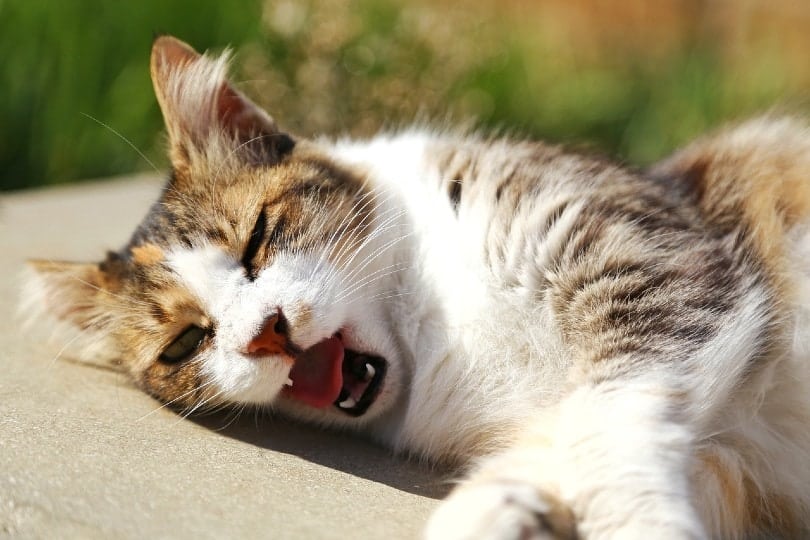Pine pellets have a range of uses but you will most commonly see them used as bedding for horses and as an eco-friendly and affordable alternative to more traditional cat litters. The top concern over switching to pine cat litter is whether pine pellets are completely safe for cats.
The truth is that pine contains phenols, which are a chemical compound that is highly toxic to cats, but the process of kiln drying during the pellet-making process can remove most of the phenols. Because of this, pine pellets are considered a safe cat litter option. But if your cat were to eat some, it’s best to seek veterinary advice right away. Continue reading to learn more.
The Potential Danger of Pine Pellets
The danger of pine all comes back to the aromatic chemical compound, phenol. Phenol, also known as carbolic acid, is toxic to all animals, we humans included. Cats tend to be much more susceptible to phenol toxicity due to their regular self-grooming habits and a deficiency of the liver enzyme, glucuronyl transferase which helps the body process and eliminate toxins.
Most pine-based cat litters go through the process of kiln drying, which removes the moisture from the pine and eliminates most, but not all the phenol within the wood. It’s important to note, however, that the kiln drying process is not full-proof, and not all pine pellets are kiln-dried. For instance, if you use pine pellets for horse bedding or stoves, or other purposes, it may contain many higher levels of phenol than pine pellet cat litter.
What Do I Do If My Cat Eats Pine Pellets?
If your cat were to ingest pine pellets, it’s a good idea to call your veterinarian, even if the pine pellets are confirmed to be kiln-dried and meant for cats. It’s very unusual for a cat to eat their litter and it could be indicative of an underlying health issue.
In addition, to be an unusual behavior that warrants a visit to the veterinary clinic, you never know how much phenol could be left behind in the pellets in question, especially those that are not meant for use as cat litter. That’s why seeking help from a licensed veterinarian is necessary. It’s important to be aware of the signs of toxicity and act quickly if your cat were to exhibit any. Excessive amounts of phenol can lead to serious liver damage and even prove fatal if left untreated.
Signs of Phenol Toxicity in Cats
- Drooling
- Lack of coordination
- Lethargy or weakness
- Tremors
- Pawing at the mouth or face
- Redness on the lips, gums, tongue, or skin
- Difficulty breathing
- Vomiting

The Pros and Cons of Pine Pellet Cat Litter
Since pine pellets have grown increasingly popular over the years and make a more environmentally friendly form of litter, it would seem like a no-brainer to choose if they were completely safe. As with anything, there are some good things about pine pellet cat litter and there are some not-so-good things. Let’s look.
Pine Cat Litter Pros
Inexpensive
Pine cat litter is one of the least expensive types of cat litter on the market. It’s comparable to clay litter in cost.
Eco-Friendly
For those looking for an eco-friendly cat litter option, pine pellets make a great choice. They are sustainable, biodegradable, and compostable, unlike most other litter varieties. Pine pellets are made from reclaimed wood from the lumber industry, so you are also getting a repurposed product.
Less Mess
Not only do pine pellets produce little to no dust like your traditional clay litter, but there is much less litter that will be tracked outside the box. This is also great for allergy sufferers, whether it is a person in the household or the cat themselves.
Controls Ammonia Smells
Pine does a great job masking the pungent scent of ammonia that is present in cat pee. Not only do the pellets break down into sawdust when they get wet, but they are also antimicrobial and will remove some odor-causing bacteria.

Pine Cat Litter Cons
Cats Don’t Always Take Well to Pine Pellets
Cats tend to be finicky and pellet litter isn’t always their preferred litter type. Whether it’s the texture, the smell, or the overall change, some cats just don’t take well to pine pellets.
Harder to Clean
Pine litter will not clump, so it’s much more difficult to clean than your normal clay, clumping litter varieties. Pine pellets turn to sawdust when they are exposed to moisture, so it’s ideal to use these pellets in a sifting litter box, as most other litter box types will only make the cleaning process more difficult.
Doesn’t Control Smell of Feces
While pine does well in battling the smell of cat urine, it doesn’t hold up against the smell of poop. Cats won’t always cover their poop in pine pellets as they do with granules, so that can make it even more smelly.
Concerns Over Trace Amounts of Phenol
As mentioned, even kiln-dried pine pellets created specifically for use as cat litter can still contain trace amounts of phenol. This does make some owners uncomfortable. Overall, pine litter is considered safe.
Conclusion
If pine pellets are properly kiln-dried and contain no additional chemical additives, they are considered a safe and eco-friendly cat litter. If your cat were to eat pine pellets, you should contact your veterinarian right away to be on the safe side. There are pros and cons to pine pellet cat litter as well, but only you and your vet can decide if that’s the best choice for your cat.














